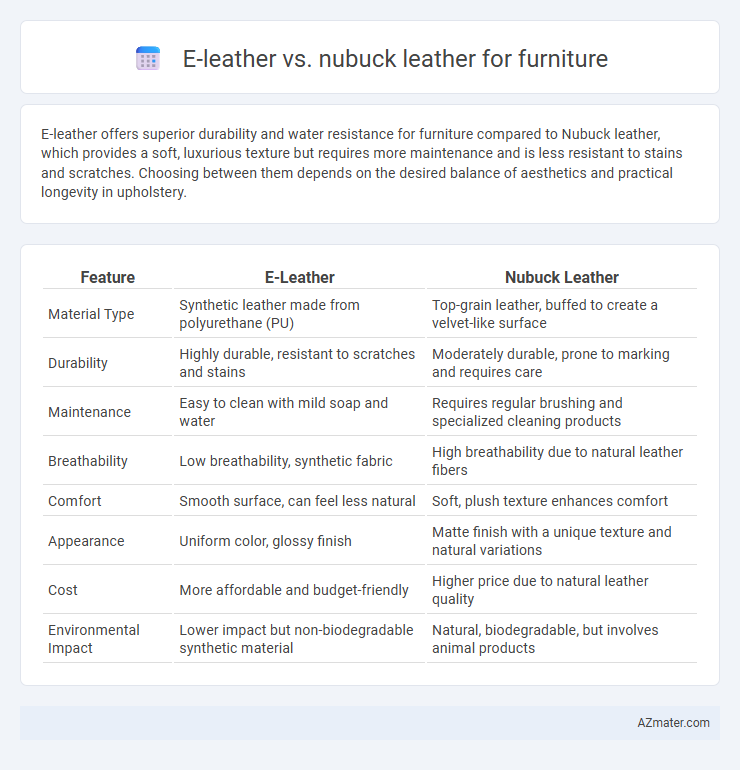E-leather offers superior durability and water resistance for furniture compared to Nubuck leather, which provides a soft, luxurious texture but requires more maintenance and is less resistant to stains and scratches. Choosing between them depends on the desired balance of aesthetics and practical longevity in upholstery.
Table of Comparison
| Feature | E-Leather | Nubuck Leather |
|---|---|---|
| Material Type | Synthetic leather made from polyurethane (PU) | Top-grain leather, buffed to create a velvet-like surface |
| Durability | Highly durable, resistant to scratches and stains | Moderately durable, prone to marking and requires care |
| Maintenance | Easy to clean with mild soap and water | Requires regular brushing and specialized cleaning products |
| Breathability | Low breathability, synthetic fabric | High breathability due to natural leather fibers |
| Comfort | Smooth surface, can feel less natural | Soft, plush texture enhances comfort |
| Appearance | Uniform color, glossy finish | Matte finish with a unique texture and natural variations |
| Cost | More affordable and budget-friendly | Higher price due to natural leather quality |
| Environmental Impact | Lower impact but non-biodegradable synthetic material | Natural, biodegradable, but involves animal products |
Introduction to E-leather and Nubuck Leather
E-leather is a sustainable, synthetic alternative to traditional leather, made by bonding polyurethane to a fabric base to mimic the look and feel of animal leather while offering enhanced durability and easy maintenance. Nubuck leather, derived from the outer layer of cowhide, features a velvety, suede-like texture achieved by sanding the grain surface, making it highly breathable and luxurious but requiring regular care to prevent staining. Both materials provide distinct aesthetics and functional qualities, with E-leather excelling in practicality and Nubuck valued for its natural softness and premium appearance.
Material Composition and Manufacturing Processes
E-leather is made from natural leather blended with polyurethane or other synthetic materials through advanced coating technologies, creating a durable, stain-resistant surface ideal for furniture. Nubuck leather is crafted from the outer side of a hide, meticulously sanded or buffed to produce a soft, velvety texture, offering a luxurious feel but requiring more maintenance due to its porous nature. The manufacturing process of E-leather involves layering synthetic polymers over split leather for enhanced durability, while Nubuck is purely natural leather processed through abrasive techniques to enhance its aesthetic and tactile appeal.
Visual Appeal: Texture and Appearance
E-leather offers a smooth, consistent texture with a sleek, uniform finish that enhances modern furniture aesthetics, making it ideal for contemporary interiors. Nubuck leather features a soft, velvety surface with a rich, natural grain, providing a luxurious, tactile appeal that develops a unique patina over time. The visual contrast lies in E-leather's polished look versus Nubuck's matte, suede-like appearance, influencing furniture style and ambiance significantly.
Comfort and Tactile Experience
E-leather offers a smooth, consistent surface that feels soft and cool to the touch, enhancing comfort with its breathable, moisture-resistant properties ideal for furniture use. Nubuck leather delivers a velvety, suede-like texture that provides a warm, plush tactile experience, adding luxury and inviting coziness to seating. While E-leather is easier to clean and maintain, Nubuck requires careful care to preserve its softness and comfort over time.
Durability and Wear Resistance
E-leather exhibits superior durability and wear resistance compared to Nubuck leather, making it an ideal choice for high-traffic furniture. E-leather's synthetic composition allows it to resist scratches, stains, and fading, maintaining its appearance over time. Nubuck leather, while offering a luxurious texture, is more susceptible to scuffs and requires careful maintenance to preserve its look under frequent use.
Maintenance and Cleaning Requirements
E-leather furniture offers low maintenance benefits, requiring only regular dusting and occasional wiping with a damp cloth to prevent stains and prolong its lifespan. Nubuck leather demands more intensive care, including frequent brushing with a specialized suede brush and the use of protective sprays to maintain its soft texture and resist dirt. Both require prompt attention to spills, but Nubuck is notably more sensitive to moisture and staining compared to the more durable and water-resistant E-leather.
Sustainability and Environmental Impact
E-leather, often made from polyurethane or PVC, offers a more sustainable alternative to traditional Nubuck leather by requiring fewer animal resources and producing less water and chemical waste during manufacturing. Nubuck leather, derived from animal hides, involves significant environmental impact due to livestock farming, deforestation, and tanning processes that release pollutants. Choosing E-leather for furniture supports reduced carbon emissions and waste, aligning with eco-friendly and sustainable interior design trends.
Cost Comparison and Value
E-leather offers a more cost-effective solution compared to Nubuck leather, with prices typically 30-50% lower due to its synthetic composition and easier manufacturing process. Nubuck leather, derived from high-quality, top-grain cowhide, commands a premium price because of its durability, natural texture, and luxurious appearance. Despite the higher initial investment, Nubuck furniture retains value longer and ages gracefully, providing superior long-term value over E-leather, which may show wear more quickly.
Suitability for Different Furniture Types
E-leather, known for its durability and water resistance, is ideal for high-traffic furniture pieces like sofas and dining chairs, where easy maintenance is essential. Nubuck leather, with its soft texture and luxurious appearance, suits low-use furniture such as accent chairs and headboards that prioritize aesthetics over ruggedness. Both materials offer distinctive qualities, making selection dependent on the specific function and environment of the furniture.
Conclusion: Which Leather is Best for Your Furniture?
E-leather offers superior durability, stain resistance, and easy maintenance, making it ideal for households with pets or children. Nubuck leather provides a luxurious, soft texture and natural appearance but requires more care and is prone to scratches and stains. Choose E-leather for practicality and longevity, while Nubuck suits those prioritizing aesthetics and willing to invest time in upkeep.

Infographic: E-leather vs Nubuck leather for Furniture
 azmater.com
azmater.com